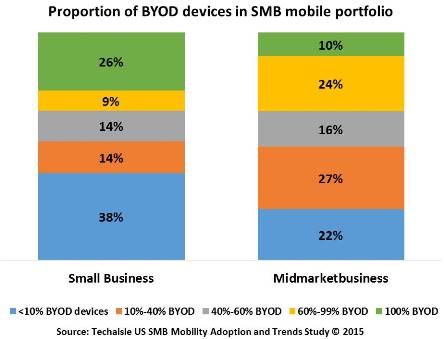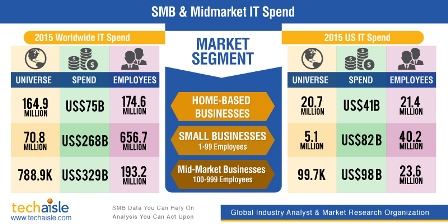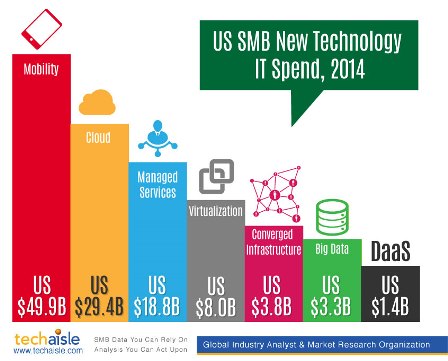The ongoing migration to server virtualization – within small businesses that have not yet adopted virtualization and within midmarket enterprises that are consolidating workloads on new, virtualization-ready infrastructure – will drive substantial near-term demand for converged infrastructure. Techaisle survey data shows that adoption of converged infrastructure is expected to double within the one year planning horizon. This is unlikely to represent ‘net new’ server demand; instead, Techaisle expects converged infrastructure growth to occur at the expense of traditional server products.
While the migration from separate server, storage and networking products to converged infrastructure is still in its early stages, the Techaisle SMB & midmarket converged infrastructure adoption trends survey shows that it is beginning to gain traction, especially within more sophisticated accounts. In the US, converged infrastructure is currently used within 32% of midmarket businesses, with another 31% planning to acquire within a year. Techaisle’s segmentation by IT sophistication demonstrates converged infrastructure adoption rises steadily with increased buyer sophistication in both the small and midmarket segments. US SMBs spent US$3.8B on converged infrastructure solutions’ implementation in 2014.
Additional survey data illustrates that suppliers of converged infrastructure should be proactive in making potential customers aware of the benefits of their technologies. While roughly half of both small and midmarket businesses describe themselves as being in the information gathering stage, one-third are currently identifying potential solutions, and 15%-20% are evaluating suppliers. It seems unlikely that buyers will ‘mix and match’ converged infrastructure technology, so it is important for suppliers to win initial orders – and the data shows that many of these purchase decisions are already underway.
While there are technical advantages that make converged infrastructure products more effective virtualization hosts than traditional servers, Techaisle’s research shows that SMB buyers adopt converged infrastructure for one or more of five primary reasons:
- to benefit from converged infrastructure’s integrated design and efficiency,
- to tap into its ability to enable centralization/management of resources,
- to capitalize on performance/time-to-benefit advantages,
- to improve IT agility and its ability to meet business needs, and
- in response to core requirements for cost savings and improved security.
In another section of the Techaisle SMB 2015 research, respondents were asked to identify projects that prompt consideration and purchase of converged infrastructure products. Comparison of small and midmarket business drivers finds both some commonality and some variations. Both small businesses and midmarket enterprises are most likely to acquire converged infrastructure to support data center consolidation, and virtualization applications as well as impetus for data migration. Key applications – Big Data and unified communications, SharePoint, and in small businesses, custom applications – are also project types that can drive adoption of converged infrastructure.
To enhance the scope of comparisons Techaisle also posed similar question to channel respondents in Techaisle’s SMB channel partner trends survey. The data provides yet another perspective reflecting the situations in which the channel is drawn into converged infrastructure decisions. Big Data – which requires a relatively wide range of competencies – is the project type that will most commonly require the channel to deploy converged infrastructure systems, and SharePoint projects which also demand a broad skill set, are the third most common project cited as a converged infrastructure adoption driver.
Question is “what sales channels are best positioned to intercept this demand?” Data shows that converged infrastructure routes to market will likely follow the pathways used to acquire software management layer that controls these physical resources. Both small and midmarket businesses are most likely to turn to hypervisor and networking vendors. Systems integrators have a substantial presence in the supply of these solutions whereas as VARs and managed service providers (MSPs) have more limited presence/appeal as virtualization solution sources.
In many ways, the key market issue surrounding converged infrastructure isn’t vendor-vs.-vendor competition, but rather, the ability of converged infrastructure as a system class to gain share quickly vs. traditional server products, while not being obviated by the cloud before attaining mass market penetration. However, suppliers are competing for share in this growth category, and understanding SMB what buyers are looking for – and what they struggle with when they adopt converged infrastructure – is important to positioning a brand as a credible solution.

















